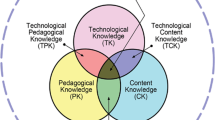Abstract
One way of viewing curriculum content is to regard it astext: i.e. as a collection of narrative and argument which helps shape learners' views of the world. School and university textbooks form part of that collection. At university level, texts encountered by future teachers help shape views of the discipline which may be transmitted to later generations of school learners. This paper is concerned with how the relationships between science and technology are portrayed in school and university textbooks. Criteria are offered for evaluating these portrayals, and examples are presented of material which meets (or fails to meet) these criteria.
Similar content being viewed by others
References
Bueche, F.J. (1975).Introduction to physics for scientists and engineers (2nd ed.) New York: McGraw-Hill Book Company.
Burgess, T. (ed.) and the Royal Society for the Encouragement of the Arts, Manufactures and Commerce (1986).Education for capability. Windsor: NFER-Nelson.
DEET [Department of Employment, Education and Training] (1989).Discipline review of teacher education in mathematics and science. Vol. 1. Canberra: Australian Government Publishing Service.
Gardner, P.L. (1990). The technology-science relationship: some curriculum implications.Research in Science Education, 20, 124–133.
Gardner, P.L. (1992). The application of science to technology.Research in Science Education, 22, 140–148.
Gardner, P.L. (1993). The historical independence of technology and science.The Australian Science Teachers Journal, 39 (1), 9–13.
Giancoli, D.C. (1984).General physics. Englewood Cliffs, NJ: Prentice-Hall.
Haber-Schaim, U., Dodge, J.H. & Walter, J.A. (1986).PSSC Physics (6th ed.) Lexington MA: D.C. Heath.
Ihde, D. (1979).Technics and praxis (Boston Studies in the Philosophy of science, Vol. 24) Dordrecht, Holland: D. Reidel Publishing Company.
Ihde, D. (1983). The historical-ontological priority of technology over science. In P. T. Durbin & F. Rapp (Eds.)Philosophy and technology (Boston Studies in the Philosophy of Science, Vol. 80), Dordrecht, Holland: D Reidel Publishing Company.
Kane, J.W. & Sternheim, M.M. (1978).Physics (2nd ed.) New York: John Wiley.
Kline, R. (1987). Science and engineering theory in the invention and development of the induction motor, 1880–1900.Technology and Culture, 28 (2), 283–313.
Kortland, K., Brouwers, J., Holl, E., van Bergen, H., van Valkenburg, G., Pieters, M. & Römgens, T. (1990).Interactie: fysica in thema's. Zeist: NIB.
Layton, E. (1971). Mirror image twins: the communities of science and technology in 19th-century AmericaTechnology and Culture, 12 (4), 562–580.
Lowe, I. (1989). The relationship between science education and technology, and the implications for teacher education. In Department of Employment, Education and Training.Discipline review of teacher education in mathematics and science. Vol. 3. Canberra: Australian Government Publishing Service.
Mayr, O. (1971). The Chicago Meeting, December 26–30 1970 [of the Society for the History of Technology]. Program Notes.Technology and Culture, 12, 238–240.
McMurry, J. (1990).Fundamentals of organic chemistry (2nd ed.) Pacific Grove CA: Brooks/Cole.
Oxtoby, D.W. & Nachtrieb, N.H. (1990).Principles of modern chemistry (2nd ed.) Philadelphia PA: Saunders College Publications.
Ramsden, J. (1992). Going in through both ears and staying there: The Salters' approach to science.The Australian Science Teachers Journal, 38 (2), 13–18.
Serway, R.A. & Faughn, J.S. (1992).College physics (3rd ed.) Fort Worth TX: Saunders College Publishing.
The Project Physics Course (1970).Teacher resource book. Unit 2: Motion in the heavens. New York: Holt, Rinehart & Winston.
Author information
Authors and Affiliations
Additional information
Specializations: science and technology education; educational measurement and evaluation.
Rights and permissions
About this article
Cite this article
Gardner, P.L. Textbook representations of science-technology relationships. Research in Science Education 23, 85–94 (1993). https://doi.org/10.1007/BF02357048
Issue Date:
DOI: https://doi.org/10.1007/BF02357048




